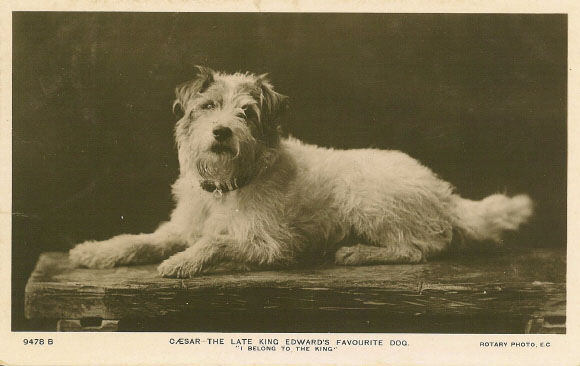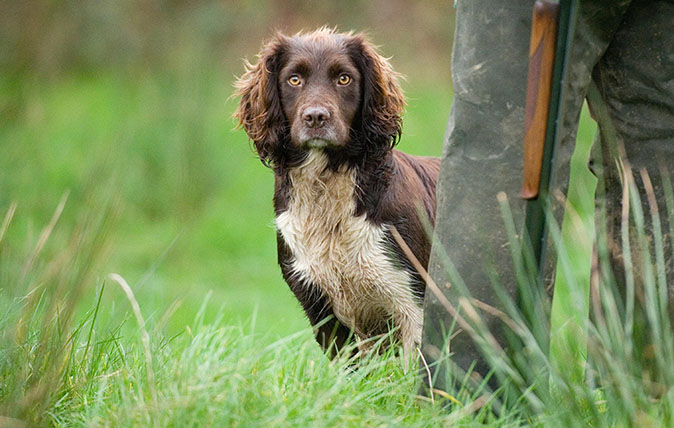Obedience isn’t always a virtue of the appealing, cheerful wire fox terrier, but Charlotte Cory, owner of Bessie, is smitten.
Every April, there’s a dog walk in Brighton with some 100 wire fox terriers. It’s always funny to see so many together, but the funniest thing is watching the faces of people walking the other way when they realise they’re about to be deluged by a tidal wave of dogs. When the pack assembles for a group photo-graph, onlookers can’t believe their eyes.
As an owner of one of these curly-haired, square-cut dogs that look as if they belong on a child’s walking aid or in a toy box, it’s an occupational hazard to be stopped with cries of ‘I had one as a child, on wheels!’ or ‘My great aunt bred them’, invariably followed by ‘You don’t see many of them these days’.
These indubitably old-fashioned dogs were developed in hunt kennels, notably the ducal ones of the Beaufort, Belvoir and Berkeley, and their sporting instincts are strong. In 1923, Capt H. R. Phipps, an MFH and renowned terrier judge, was out riding when he was enchanted by the sight of a handsome wire bitch, but the owner, a Mr Foster, refused to sell either her or one of her five puppies.
However, in time, Foster changed his tune because the puppies had developed into incorrigible fighters – he feared they might kill each other – and Captain Phipps became the owner of Ch. Talavera Simon, a legendary dog in wire-breeding circles.
Initially, Simon’s appalling show-ring behaviour negated his outstanding conformation, but he became a reformed character and most of today’s wire fox terriers can be traced back to him. If you’re thinking of getting one, here’s what you ought to know first.

Don’t expect them to do what you ask them
As with Captain Phipps’ original Simon, the wire is not one of the most biddable breeds. They’re not eager to please – they depend on their looks to do that – and know what they want out of life.
Their single-minded determination is remarkable, as is their curiosity, energy and endless joie de vivre; wire fox terriers stay puppyish all their lives. They’re eminently trainable, but make it clear – by jaunty body language and mischievous tail wags – that it’s up to them whether they execute your orders or not.
You never really own one
It’s a cliché, but it’s true: you never really own one, it owns you. As they’re so intelligent, they’re probably happiest when taught tricks or even complex routines. Troupes of them used to tour the country putting on shows and theatrical performances at provincial theatres and seaside piers.
Responsible breeders give would-be adopters of puppies a hard time; I’m not sure we would have passed the examination to take Bessie home if I hadn’t made it clear that she would be my third and I had no illusions.
My first two were rescue dogs, with entrenched habits. Rufus was re-homed when his previous owner had a baby – he went beserk at the telephone ring and used his powerful bounce to leap up and bite the nearest bottom. Little Maudie was sweet-natured, but would fight ruthlessly over food. With Bessie, we knew any loopy behaviour had to be curbed before it took hold.

The author, Charlotte Cory, with Bessie
They’re famous in literature and film
With their good looks and enormous personalities, you can see why these particular terriers have played major roles in detective films and fiction. Hergé was notorious for giving Tintin’s dog Snowy (Milou in the French) sticky-up ears instead of the breed’s neatly folded envelopes, but, in fact, the dog’s ears will prick up at the slightest provocation.
The popular 1930s ‘Thin Man’ film series, starring William Powell and Myrna Loy, had Asta upstaging the famous sleuths at every turn and invariably stealing the show.
The comic recalcitrance of Montmorency, the canine member of Jerome K. Jerome’s famous boat trip, is perfectly characterised: ‘[His] ambition in life, is to get in the way and be sworn at. If he can squirm in anywhere where he particularly is not wanted, and be a perfect nuisance, and make people mad… then he feels his day has not been wasted.’
Agatha Christie had one called Peter, star of Dumb Witness as Bob. The book’s dedication says it all: ‘Dear Peter, Most faithful of Friends and dearest of companions, a dog in a thousand.’
She drew on the breed’s penchant for endless play to enable Poirot to solve his mistress’s murder. The relationship between the detective’s foil, Capt Hastings, and Bob is wittily delineated – only a writer of Christie’s brilliance and daring could give voice to an animal so accurately.

They love their food – and are incorrigibly naughty about getting it
Pulled off an abandoned chip spotted on the pavement, they will remember its precise co-ordinates and strain at the lead – and they often need to be kept on a lead – ever after when approaching that location.
Thomas Hardy owned a notoriously badly behaved dog that dominated life at Max Gate. Literary pilgrims would find Wessie running up and down the dining table vying with them for food. He bit the postman and shredded trouser legs, but Hardy adored him, buying him a radio so he could listen to Bach (his favourite) and giving him a luxurious eiderdown in his study.
When Wessie died, Hardy wrote two of the most moving poems ever penned to a dead pet, with the same gut-wrenching, lyrical wistfulness (but none of the guilty regret) with which he mourned his first wife.

The wire-haired outnumber their smooth-haired cousins
The sporting fox terrier, originally bred to locate foxes when they went to ground, now has two separate Kennel Club breed standards (wire and smooth haired). Both were developed in the 19th century, with strains of Old English terrier, black and tan terrier, greyhound and beagle, and both breed standards demand a dog that is ‘on tiptoe of expectation’ and with a ‘friendly, forthcoming and fearless’ temperament.
However, the wire has significantly outstripped the smooth in numbers; in 2017, 82 smooth-haired puppies were registered with the KC compared with 668 wire; by the third quarter of 2018, the ratio was 99 to 432. The smooth is now classified as a vulnerable native breed.
Their faithfulness is the stuff of legend
When Edward VII died, his devoted terrier, Caesar, refused to leave the coffin. Postcards of Caesar in the funeral procession established the breed’s reputation for undying fidelity.

A postcard of Caesar, the late king’s famously loyal dog. Pic: Wiki Commons
They’re quintessentially English
I think of these dogs as typically English. I was walking Bessie in France recently when I heard a passer-by saying to his friend in French: ‘If I were ever to get another dog, it will be one of those. But I am too old. They are hard work.’ His companion nodded and replied: ‘Certainement, ils sont très Anglaises.’
By which, I’m sure, he meant very stylish…
The National Fox Terrier Meet is at Chatsworth, Derbyshire, at 10.30am on June 22 – www.foxterrierrescue.co.uk . You can find out more about them at www.wirefoxterrierassociation.co.uk and www.thefoxterrierclub.co.uk.

The Italian Greyhound: Tiny, beloved of royalty and anything but fast (until they put their minds to it)
Italian Greyhounds are a conundrum: for all their speed potential they're usually infuriatingly slow, miniature-sized – and they're not even

Let sleeping dogs lie: 8 stylish dog beds for cool canines
A new generation of beds and accessories offers the ultimate in canine chic.

Which breed makes the best gundog? The pros and cons of labradors, spaniels, terriers and more
Whether you own labradors, springers, cockers or a mix of all three, debate over which gundog is best has raged




